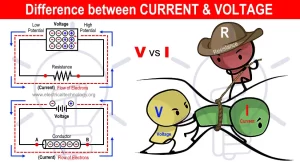Two fundamental concepts are crucial in electrical circuits and devices: voltage vs current. Understanding their differences and how they relate to each other is essential for anyone delving into the world of electronics. This comprehensive guide will explore the disparities between voltage and current, their definitions, and their significance in various applications.
Part 1. What is battery voltage?
Voltage, often called electric potential difference, measures the electric potential energy per unit charge within a circuit. In simpler terms, it represents the force that drives electrical current through a conductor. Battery voltage refers to the electromotive force (EMF) generated by a battery, which provides the necessary energy to power electrical devices.
When we talk about battery voltage, we are essentially discussing the potential energy difference between the positive and negative terminals of the battery. This potential difference creates an electric field that propels the flow of electrons, thereby enabling the transfer of electrical energy from the battery to connected devices.
Part 2. What is battery current?
On the other hand, current is the flow of electric charge through a conductor or circuit. It is measured in units called amperes (A) and is represented by the symbol ” I .”The voltage drives current in a circuit, directly proportional to the voltage applied and inversely proportional to the resistance encountered.
In the context of batteries, current refers to the flow of electrons from the battery’s negative terminal to its positive terminal. The electrons, propelled by the voltage difference, travel through the circuit, powering electrical components along the way.

Part 3. Difference between voltage and current
While voltage and current are closely related, they represent distinct aspects of electrical systems. Understanding their differences is crucial for comprehending the behavior and functioning of circuits. Here are the critical disparities between voltage and current:
1. Definition:
Voltage is the difference in electric potential or the force that drives current flow. It is measured in volts (V). On the other hand, current is the actual flow of electric charge and is measured in amperes (A).
2. Nature:
Voltage is a scalar quantity with magnitude but no specific direction. Current, however, is a vector quantity, as it has both magnitude and direction.
3. Representation:
Voltage is typically represented by the symbol “V,” while current is denoted by “I.”
4. Role:
Voltage serves as the driving force for current flow. It provides the necessary energy to move electrons through a circuit. Current, on the other hand, represents the actual flow of electrons.
5. Measurement:
Voltage is measured using a voltmeter, while current is calculated using an ammeter.
6. Dependency:
Voltage and current are interdependent but distinct. Voltage creates an electric field that propels the current flow. In contrast, current depends on the voltage applied and the resistance encountered in the circuit.
Part 4. Relationship between voltage and current
Let’s explore how voltage and current are connected and how changes in one affect the other:
Direct Proportionality:
- Voltage and current are directly proportional. This means that as voltage increases, current increases, and vice versa, assuming other factors remain constant.
- For example, suppose the voltage across a circuit is doubled. The current flowing through the circuit will double, provided the resistance remains the same.
Ohm’s Law:
- Ohm’s Law describes the relationship between voltage, current, and resistance in a circuit. It states that the current flowing through a circuit is directly proportional to the voltage applied and inversely proportional to the resistance encountered.
- Mathematically, Ohm’s Law can be expressed as I = V / R.
- Here, I represents the current in amperes (A), V represents the voltage in volts (V), and R represents the resistance in ohms (Ω).
Resistance Influence:
- Changes in resistance can impact the relationship between voltage and current.
- If resistance increases while voltage remains constant, the current will decrease. This is because higher resistance restricts the flow of electrons, resulting in a decrease in current.
- Conversely, the current will increase if resistance decreases while voltage remains constant. With lower resistance, there is less hindrance to the movement of electrons, leading to an increase in current.
Power Calculation:
- Voltage and current are crucial for calculating power in an electrical circuit.
- Power, measured in watts (W), is the product of voltage and current: P = V * I.
- This relationship highlights that both voltage and current play a significant role in determining the amount of power consumed or delivered by a circuit.
Series and Parallel Circuits:
- In series circuits, voltage is divided among the components, while the current remains the same throughout the circuit. The sum of the voltages across individual components equals the total voltage applied.
- In parallel circuits, the voltage remains constant across each branch while the total current is divided among the components. The sum of the currents in each branch equals the total current flowing into the circuit.
Part 5. Conclusion
In conclusion, voltage and current are integral components of electrical systems. Voltage represents the electric potential difference that drives current flow, while current signifies the actual flow of electric charge. Understanding the disparities between voltage and current and their interdependence is essential for comprehending the behavior of electrical circuits and devices.
Part 6. FAQs
-
Can voltage exist without current?
No, voltage cannot exist without current. Voltage is the driving force that propels current flow. Without a voltage difference, there would be no potential energy to push electrons and no current flow. -
Does higher voltage mean higher current?
Yes, higher voltage typically results in higher current. Voltage acts as the driving force behind current flow in a circuit. When voltage increases, it provides more energy to push electrons through the circuit, increasing current. -
What is the difference between current and electricity?
Current is the flow of electric charge, typically measured in amperes (amps). At the same time, electricity is the overall term used to describe the phenomena related to the flow of electric charge. In simpler terms, current is the movement of electrons in a circuit. At the same time, electricity encompasses the broader concept of electrical phenomena and its applications. -
What happens if the voltage is too high?
If the voltage in a circuit is too high, it can lead to various undesirable consequences. Excessive voltage can cause components to overheat, burn out, or even pose a risk of electrical shock. -
Is energy a current or voltage?
Energy is neither current nor voltage. Instead, energy is the capacity to do work. Voltage represents the potential energy difference between two points in a circuit. At the same time, current is the flow of electric charge, which can be seen as the movement of energy through the circuit. Therefore, energy is related to both voltage and current but is distinct from them.
Related Tags:
More Articles

Overview of Deep Cycle Lithium Battery
In this article, we explore the life, voltage, capacity, and charging considerations of deep cycle lithium batteries.
How Long do Lithium Batteries Last?
How long do lithium batteries last? we will explore the factors that influence the lifespan of lithium batteries and provide insights into their longevity.
How to Choose the Best LiFePO4 Battery?
Choose LiFePO4 batteries for superior performance, safety, and versatility in EVs, UPS, and backup power. This guide helps you make informed decisions.
Get 12v Lithium Car Battery As a Power Source for the Ride
Make the right choice for your vehicle's battery needs by installing a 12 volt lithium car battery. You will enjoy maintenance-free longevity with this change.
Everything About A Small Lithium Ion Battery
Discover the features, uses & future potential of a small lithium ion battery. A compact and tiny powerhouse ideal for smartphones, wearables, drones & more.





